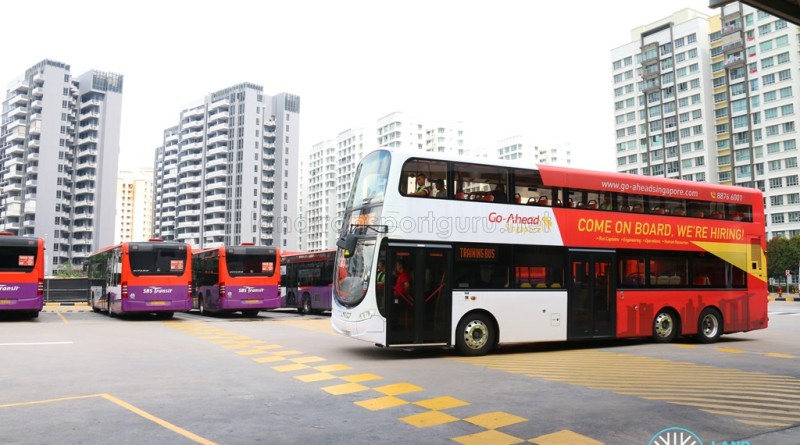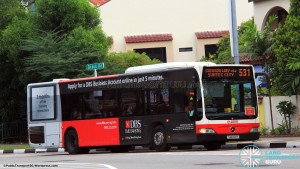Interlining, also known as ‘cross-overs‘ in local bus enthusiast lingo, is a technique used in bus scheduling where a single bus driver is scheduled to perform multiple bus routes over the course of his shift. This approach benefits bus operators by utilizing their resources more efficiently.
The practice of interlining has been used by SBS Transit and SMRT Buses for a long time, but rose to notoriety in September 2016 when aggressive use of the interlining model at Go-Ahead Singapore resulted in a spate of Bus Captain resignations as drivers struggled to get to grips with the scheduling method.
Interlining arrangements are common in Australia and the United Kingdom, where Go-Ahead and Tower Transit — the Republic’s two newest public bus operators — are headquartered. Tower Transit, which started operating 26 bus services in May 2016, adopts a “conservative amount” of interlining in Singapore.
How interlining works
Interlining is a resource-efficient method of bus scheduling where where bus drivers are rostered to operate trips on two or more bus routes. This form of scheduling maximizes the efficiency of bus operations by offering a flexible method of pairing up driver scheduling and bus scheduling.
The benefits of interlining is best explained with low-frequency bus routes. For example, two bus routes sharing the same terminating point have a frequency of 20 minutes each, and a full-journey duration of 10 minutes and 25 minutes each. Rather than implementing a 10 or 15-minute layover after every trip respectively, the schedules of these two routes can be interlined, such that a bus would perform one round of each service continuously, a total of 35 minutes, followed by a 5-minute break.
Without interlining, one bus would be deployed for the 10-minute route and another two buses deployed on the 25-minute route. With interlining, only two buses are required to meet the operational requirements of these two services. Interlining works the same way in Singapore when it comes to new BCM operators like Tower Transit and Go-Ahead, which use interlining more frequently than SBS Transit and SMRT Buses to maximize resources as part of the competitive tendering model.
Interlining is sometimes combined with CLOWBus (Crew Lay-Over Without Bus), better known as ‘jumpbus‘ to bus enthusiasts, which involves the same bus being rostered to multiple drivers to minimize unproductive layover time. As a consequence, bus drivers may be allocated to different buses within a single shift.
SBS Transit and SMRT Buses
Historically, SBS Transit and SMRT Buses have used interlining sparingly, often to optimize peak hour resources, cover mealbreak times on low-frequency routes, and trying to fit a driver into the standard duration of a single shift.
Types of commonly used types of interlining are:
- Early morning supplementary trips
- Maximizing Peak Period Service schedules
- Extra Feeder trips during Peak hours
- Maximizing Special Service schedules
- Meal break replacement
Note: Some of the below interlining examples has since been terminated due to operator changes.
1. Early morning supplementary trips
Several bus services are interlined to provide early morning supplementary trips on other bus services which encounter higher demand levels earlier in the morning. This can also be used to add revenue service trips from an interchange near a bus depot to another interchange further away from where the same Bus Captain would be deployed on another route.
| 3 × 37 | Additional early morning trips of Service 37 using buses from Service 3 (High demand towards Changi) |
| 22 × 136 | Additional early morning trips of Service 136 using buses from Service 22 |
| 857 × 965A | Additional early morning trips of Service 965A using buses from Service 857 (High demand towards Yishun) |
2. Maximizing Peak Period Service schedules
Most Peak-hour services operate in a single direction during the peak hours where the flow of commuters is the strongest (e.g. Outlying estates to Central Business District). As a result, outside of a single trip during the peak hours, interlining with other bus services are common. SMRT Buses makes heavy use of this sort of interlining.
| 901 × 587 × 922 | Premium 587 is interlined with Feeders 901 and 922 where it runs additional trips before and after its 587 run |
| 854E × 531 | Express 854E from Yishun to Bedok and Premium 531 from Simei to CBD achieves minimal dead mileage |
| RWS8 × 531 × 969A | RWS8 bus in the evening performs 531 (Shenton Way to Simei) followed by 969A (Tampines to Yishun). Maximizes revenue service distance while reducing dead mileage. |
| 925 × 190 | Service 925 interlined with high-demand Service 190 to provide late-evening additional trips (downroute from YMCA to CCK) |
| Fast Forward services | Fast Forward services are often interlined to operate late morning and late afternoon trips on their parent services, e.g. 14e and 196e. Service 30e is an exception; drivers are interlined with Service 222 to provide early morning and late evening trips. |
| Premium services | SBS Transit Premium services are often interlined to operate early morning trips on their parent services, e.g. 62 × 569, 85 × 558, 39 × 557 and 80 × 550 |
The benefits of interlining are obvious when compared to several peak-hour duties which only span a few hours, which is an inefficient use of resources. Examples include 868AM01, which only performs 1 trip of Express 868 in the evening, and the split-shift duties of Express 513, which only perform one forward and one return journey for the entire day.
3. Extra Feeder trips during Peak hours
Several trunk services are interlined with Feeder bus services to provide additional trips, and occasionally between Feeder services themselves. SMRT Buses makes heavy use of this sort of interlining.
| SBS Transit | 15 × 354 | 55 × 410 | 179 × 241 |179 × 242 | 199 × 243 | 265 × 268 | 315 × 317 |
| SMRT Buses | 190 × 300 | 804 × 806 | 853 × 806 | 169 × 901 × 902 | 169 × 911 | 187 × 911 | 961 × 912 | 951E × 901 | 951E × 913 | 971E × 922 and many more |
4. Maximizing Special Service schedules
Most Special services have unique operating hours, and to fit these services into conventional shifts, interlining is done to benefit other routes. Examples include:
| CT8 × 268 CT18 × 228 |
CT8 and CT18 operate only during the off-peak hours (from 10am to 5pm) on Weekdays. They are interlined with Feeder routes 228 and 268 during the peak hours. |
| SMRT NightRider | Interlined with trunk routes to provide additional late-night capacity. 960 × NR2 | 75 × NR3 | 970 × NR5 | 61 × NR6 | 171 × NR7 | 190 × NR8 |
| SBS Transit Nite Owl | Interlined with trunk routes to provide additional late-night capacity. 133 × 1N | 65 × 2N | 195 × 3N | 518 × 4N | 502 × 5N | 132 × 6N |
5. Mealbreak replacement
Services with low frequencies and small fleet sizes are often interlined with other bus services to facilitate mealbreak times. While Bus Captains take a 20+ minute mealbreak, the missing trip is covered by an interlined bus from another route. Examples include:
| 64 × 11 | A long-practiced arrangement, a Service 64 bus will travel from Sims Place to Lorong 1 Geylang to cover a trip of Service 11 during mealbreak times. |
| 82 × 84 | Under SBS Transit, a trip of Service 84 was performed by an interlined Service 82 bus during mealbreak times. |
| 400 × 402 | Service 402 is interlined with Service 400 during mealbreak times |
BCM Bus Operators
Under the Bus Contracting Model (BCM), operators make more frequent use of interlining to save resources. With competitive tendering in play, bus operators (such as Tower Transit and Go-Ahead) are inclined to deliver the required service levels using the most resource-efficient methods. Expected resource usage figures are submitted by bus operators during the tendering process and is a key figure used to calculate the contract bidding sum. Hence, operators find it advantageous to ‘do more with less’- running their bus services reliably using the least number of buses and drivers.
Interlining in Tower Transit and Go-Ahead is more prevalent than in SBS Transit or SMRT Buses scheduling, with bus drivers rotated around different routes in the day with few distinct patterns. This is because operators treat Bus Scheduling and Driver Scheduling as separate entities, with Bus Scheduling dictating the service operation and Driver Scheduling simply allocating bus drivers to fit the bus schedules most efficiently.
Tower Transit Interlining
“We were aware that interlining was practiced conservatively in Singapore. As a result, we have made only limited use of interlining, and have ensured that the bus captains involved were well trained and prepared for the change.” – Mr Neil Smith, Tower Transit chairman
Tower Transit claims to practice interlining ‘conservatively’ in their local operations, and appears to be the case. Unlike Go-Ahead, Tower Transit’s early operational hiccups were not the direct result of interlining but rather resource allocation issues, which have since been resolved.
Go-Ahead Interlining
The practice of interlining was blamed for a spate of Bus Captain resignations in September 2016 after drivers could not adapt to the practice of “driving a number of different routes during the week, instead of one single route” as Go-Ahead claimed, but in fact, Go-Ahead was routinely scheduling drivers on multiple routes a day, which adds up to many bus routes a week. Go-Ahead has since modified their existing bus schedules to heavily cut down on the scale of interlining.
Gallery:
Express 854E from Yishun to Bedok was previously interlined with Premium 531 from Simei to Shenton Way, with one bus performing one trip of both services on weekday mornings.
See Also:
External Links & References:
- —


So boring meh.😑